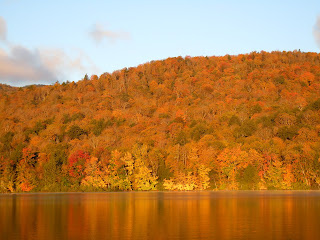Sumac is my favorite plant at the moment. It is abundant, beautiful, delicious and extremely useful (even in November). I used to fear Sumac because of the rumors of the dreaded Poison Sumac. I never went near the stuff because I was afraid of breaking out in an oozing rash. However, the only danger of (being) rash was my fear of the stuff since Poison Sumac is easily identified by it's white berries and the fact that it grows mostly in wetlands and is more shrub-like than tree-like. As long as you keep in mind the glaring differences you are not likely to mistake the two based only on the similar leaf shape.
Sumac is full of Tannin which in itself renders it useful for many purposes. For instance, Tanning animal skins. It is also a fine dye mordant and can in fact be used as a dye on it's own. Different parts and varieties of Sumac are preferred depending on what dye color you are using the plant as a mordant for.
 |
| Smooth Sumac Berries |
Archaeological evidence has revealed a great number of Sumac seeds in Native American 'kitchens' (or fire-pits & ovens) as early as the 11th century. More recent accounts (16th - 18th century) give specifics about the uses of Sumac. It was used as an aid after childbirth for bleeding problems, as well as for bleeding problems due to other injury or menstruation. It was also used for various kinds of inflammation such as sinuses, sore throats, rheumatism, etc. Sumac is also a good astringent and was used to treat gangrene. Scurvy was treated with Sumac, Dysentery was treated by Sumac suppository, toothaches packed with Sumac 'gum', and fevers rumored to be broken by ingesting Sumac. Contemporary sources mention Sumac as being useful to calm the nerves and increase focus, as well as being a legitimate and useful anti-inflammatory.
All parts of the plant are used - leaves, roots, berries and branches. To be used medicinally Sumac can be boiled and reduced to a thick consistency, drank as a warm tea or simmered in wine.
Sumac leaves, particularly when they turned red in the fall, were dried and widely used by the Native Americans for smoking. They either mixed the Sumac with tobacco and sometimes other plants, or smoked it on its own.
 |
| nice fuzzy floaters in the top of the glass |
It is well known that Sumac makes a refreshing 'lemonade' as it is commonly called. This is easily accomplished and quite delicious. The batch I made was from Smooth Sumac berries. I picked them in November and they were still bright red and full of flavor. I don't think it tastes much like lemons but it is tart, and tastes a little like purple-flower raspberries after the sourness melts away. I must be honest, the true motivation for making the sumacade as I prefer to call it was to make wine. Of course! Actually, I had read about mixing a bit of it with hard cider to lend it's tannins to the flavor profile of the cider. I also found several recipes for Sumac Wine. I wound up with nearly 3 gallons of sumacade, added sugar and cider and it is currently bubbling ferociously as it ferments. I hope it does not spoil as I would really like to taste the finished product.
To make sumacade you can either boil or soak the berries. Boiling kills off some of the vitamins so I opted to soak them in cold water overnight.
Sorry about these picture qualities - I still included them so that you could get an idea of the process. After soaking & mashing the berries a bit I strained them through muslin to get rid of any debris.
After adding sugar and cider, I used my hydrometer to check the specific gravity, sugar content and potential alcoholic content of the wine. The 10 showing in the picture is the potential alcohol content (about 20% sugar)
I then added the Sumac & Apple wine to the rest of the cider. The Sumac is on the far left and is already nearly as clear and light in color as the jug just to the right of it.


























































